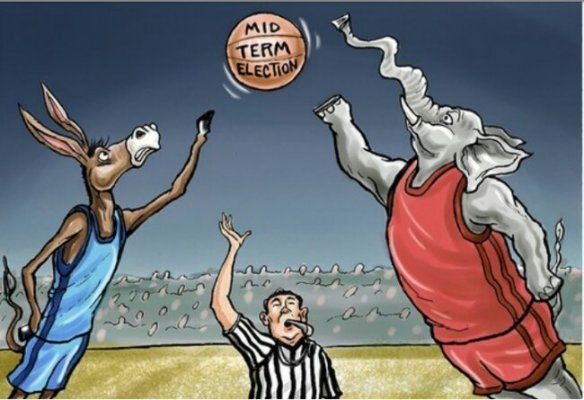One very long and drawn-out election season’s already been fitfully left behind, but that hasn’t stopped pundits from casting their gaze on another upcoming ballot battle: next year’s midterm elections.
Though not as popular nationally as presidential elections, midterm votes are seen as powerful referendums on the sitting president’s agenda, as well as a means to decide how power is brokered in the often divided and ideologically warring houses of Congress.
Every retirement, every scandal, and yes, even every death, is seen as a potential Congressional opening by two parties interested in taking full control of the government. And as the tea leaves seem to show, neither party can claim to have an advantageous lead… so far.
Toss-Ups
When citizens cast their midterm votes on November 4, 2014, most eyes will be on the very contentious Senate races. That branch of Congress is currently made up of 53 Democrats, 45 Republicans, and two independents. And though Democrats control the senate by a clear majority, several announced retirements have made the prospects of them maintaining their hold after the elections a little more unclear. So far, six Democratic senators have announced they will not be seeking reelection, compared to just two retiring senators on the Republican side (though one of the expected-to-retire Democrats, New Jersey’s Frank Lautenberg, passed away June 3. New Jersey’s Republican governor, Chris Christie, has scheduled a special election in October to fill the seat).
The early departure of heavily funded incumbents has created unexpected toss-ups in states that were once considered safe. Should Republicans pick up all the seats being vacated by the Democrats while losing as few of theirs as possible, the chances of them taking over the Senate are very high. This would lead to a completely Republican-dominated Congress, as the GOP already has a strong majority in the House: 233 against the Democrats’ 200 seats. Of course, control of the House could shift should Democrats make some unexpected gains. One of the more surprising retirement announcements from that chamber came in May, when Tea Party darling Congresswoman Michele Bachmann stated she would not be seeking reelection. Strategists thought the Minnesota representative’s exit would clear the way for businessman Jim Graves, her former opponent. However, Graves himself said he would not be running for Bachmann’s post shortly after her announcement. This air of uncertainty has created one of the most visible toss-ups in what was once considered a safe Republican stronghold.
Presidential Stakes
Though the president’s name won’t be on the ballot next year, it’s safe to say many of the issues he has fought for most certainly will. That’s because midterm votes are usually seen as critiques of the job the commander-in-chief has been doing since his election. The midterms of 2006 saw Democrats taking over Congress, which pundits analyzed as voter disapproval of George W. Bush’s war policies. A similar lesson was gleaned from the GOP’s takeover of the House in the 2010 midterms, when young, ultra-conservative congressmen swept that chamber through voter insecurity over Obama’s health-care legislation. As the president wades more deeply into controversial policies, the public’s votes will be seen as a gauge of their approval on issues such as same-sex marriage, immigration reform, overhauls of the education system, foreign policy, and even the specter of “Obamacare,” which remains as polarizing as it was back in 2010.
The chief executive’s daunting task will be to hold on to the Senate while trying to win back the House, all while preserving his legacy and defending his legislative record from Republican attack. To do this, political analysts have suggested Obama and Democrats seek a way to revive the strong coalition of young and minority voters that helped sweep him into power in both past presidential elections. This can prove a major challenge, as midterm elections have always been beset by historically low turnout, especially in those two demographics, according to the Center for Voting and Democracy. The only way to rouse these groups would be through strategies already employed in previous bigger elections, mainly the use of internet tech and social media to build grassroots activist movements. The administration could also tout some of the positive aspects of Obamacare, such as the expanded role it will have for mental health and substance use disorder benefits, a cornerstone of the president’s new policy on the fight against drug and alcohol abuse. By stressing his legislation’s role in tackling the root of alcohol abuse in Minnesota or other states known for their high numbers of alcohol dependence, the president will be able to showcase the practical aspects of his more controversial laws.
Decisions
Despite the lower appeal midterm elections have for most voters, these are the campaign wars that decide which course the government will take for the next few years: whether it be a united Washington under the control of one specific party, or a fractured government beset by constant infighting. Political careers can be made or destroyed at this time, and coalitions formed or disbanded. But no matter the outcome of these bitterly fought seats, at least there will be one clear winner: pundits with more tea leaves to pore over.








